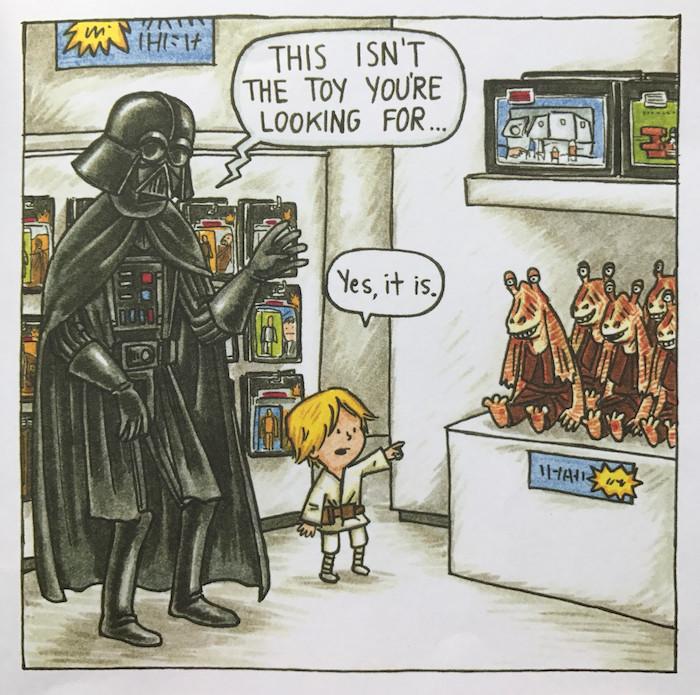Welcome to Rogue One Week! With the release of Rogue One, set in the years before A New Hope, we finally get our first stand-alone Star Wars movie. This week we’ll be analyzing the greater Star Wars universe from every conceivable angle — the storytelling, the merchandising, the mythology, and the fandom. May the Force be with you (while you read).

For Christmas last year, my two boys, then 4 and 2, got a delightful children’s book that doubles as an explicit spoiler for one of the most shocking and indelible moments in American film history. It’s called Darth Vader and Son. Little cartoons of Darth Vader doing sweet, mundane dad stuff with an also 4-year-old Luke Skywalker. Teaching him to ride a bike. Visiting the banthas at the zoo. Fielding queries on where babies come from, and why it’s called the Death Star, and whether or not they’re there yet. Taking a soccer ball to the nuts. Saying fatherly things like “Your skills are complete” and “I have you now” and “Perhaps I can find new ways to motivate you.” It’s a lot of fun for something that also ruins a huge part of the fun, twee, and meta as hell. At one point, this happens …

… because not even Star Wars characters in Star Wars merchandise are free from the tyranny of Star Wars merchandise.
My kids have never seen Star Wars, nor any of its six-going-on-seven descendants, as the movies themselves would undoubtedly either bore or frighten the shit out of them, or both. But they know, and love, the characters intimately. They can impersonate C-3PO, or a Tusken Raider, or Han Solo yelling “Don’t get cocky!” They eat their breakfast on compartmentalized The Force Awakens plates: toast in the Stormtroopers part, strawberries in the Chewbacca/Finn/Rey part, blueberries in the Kylo Ren part. They equate Yoda with God for reasons both too simple and too complex to get into here. When my oldest turned 5, he requested a Star Wars–themed birthday party; after much consternation, I agreed to dress up like Darth Vader and let the kids whack me with pool noodles cut up to look like lightsabers. Incredibly, nobody cried. Not even me.
Mel Brooks was all over this back in 1987: I refer you to the classic “MERCHANDISING!” scene from Spaceballs, which is, incidentally, a better film than any in the Star Wars universe save The Empire Strikes Back. “Where the real money from the movie is made!” Brooks crows, showing off such promotional items as “‘Spaceballs: The Flamethrower!’”
And that was nearly 30 years before Mickey Mouse got involved. Disney’s $4 billion acquisition of Lucasfilm in late 2012 was embraced by many superfans: It suggested that George Lucas himself would hold less sway over the coming sequels, which would in turn be mercifully less likely to include scenes involving Jar Jar Binks, the Senate, or both. But the true force of this merger could be better felt at, say, Target. At midnight or so, during last year’s September 4 Force Friday blowout, a Star Wars–specific retail-therapy session generated an estimated $1 billion in sales that day. Nobody sells you more shit with more aplomb than Disney, which rode December 2015’s The Force Awakens — the film itself nearly an afterthought by that point — to blockbuster profits earlier this year. They obliterate the art-capitalism divide by turning capitalism into the finest, highest-brow art of all.

I have no concrete childhood memories of sitting through any of the first three Star Wars movies; they simply came preloaded at birth, a mandatory, memory-hogging quirk of the American operating system. (I was 2 years old when The Empire Strikes Back came out.) The X-Wing toy, however, I remember perfectly. That one was the best. No idea how I found out Darth Vader was Luke Skywalker’s father: Maybe it was Vader himself onscreen, or maybe it was my buddy Joe Bommarito down the street. I forgive Joe, if indeed it was Joe. He had many other fine qualities, and also, crucially, an X-Wing.
Of the galactic amounts of Force Awakens merch unleashed upon the world last year, my kids loved the phone-app-controlled BB-8 the best. (Which their parents, cruelly, declined to buy them, given its $129 price tag, though it was, indeed, super dope.) As for Dad, far cheaper, just as delightful, and far more essential were Nestle’s Coffeemate series of branded dairy creamers. (When you think Boba Fett, think Italian Sweet Créme.) At the conclusion of my 5-year-old’s birthday party, he got the sword Dad-as-Darth-Vader was holding as a present, which was actually Kylo Ren’s sword with the weird cross guard thing, which a few of the smarter-assed kids at the party pointed out to Dad-as-Darth-Vader, who in turn suppressed the urge to “accidentally” step on those kids.
Pre-kindergartners today. No respect. It is strange that most Star Wars merchandise is still designed for the much younger set, given that the films themselves are threatening to leave kids behind entirely. The Rogue One merchandising blitz has been positively demure by comparison — there is no BB-8 equivalent, at least — perhaps because it turns out you can’t describe the movie without using the word gritty. It’s an Adult Star Wars Film apparently, as requested by no one: It’s the entry in the franchise most likely to have its own flamethrower. And it’s pushing this universe even further away from its ostensible target audience, who are stuck eating blueberries off the face of a villain far too terrifying to regard onscreen.
Rogue One is also, of course, the first Star Wars film to arrive only a year after the last Star Wars film, as opposed to the usual years-long (if not decades-long) interlude. Part of the muted promo push is likely a fear of oversaturation, of fatigue, of backlash. This movie is a side-quest sorta deal, too, a prequel to the 1977 original within a franchise where prequel is a 20-pound curse word. Given all that baggage, rolling it out with an explicit “this one’s for the adults” aura of grimy badassness makes sense, sure. There’s a new Duracell commercial where a bunch of kids help R2-D2 sneak into a hospital; barring that, I’m not positive my kids would even know another new Star Wars movie exists.
Mom and Dad are thus stuck watching Rogue One alone, a little leery of exactly how gnarly it’s trying to get. At best, this could represent a mature and compelling new direction; at worst, it could be the same bullshit Dark, Gritty Reboot mentality that has poisoned everyone and everything from Batman to Transformers to Archie to Wolverine. The kids are mature enough for a Star Wars gift shop, but not a new film. That merchandising blitz will likely keep spoiling all the plots for them anyway, and exposing them to the attendant “why doesn’t Rey have an action figure” culture clashes. Star Wars is just a birthday-party theme to them, and for now, given their shaky pre-K attention spans and Disney Junior’s robust rotation of commercials, they’ve largely moved on: to Blaze, to Mario, to Zootopia, to the Teenage Mutant Ninja Turtles.
But they’ll be back. And this is the strangest thing: They’ll know absolutely everything — Vader is Luke’s father, Luke and Leia are brother and sister, Han Solo gets frozen in carbonite but it turns out fine, Chewbacca is the best, the prequels are trash and should be avoided at all costs — long before they settle in for their first-ever opening crawl. They won’t mind. Star Wars is just capitalist lore at this point, added to the pile of important stuff you learn as a kid long before you have any idea why. Earlier this year, I watched a harried dad hustle his crying 7- or 8-year-old son out of a screening of Batman v Superman less than 10 minutes into the movie. Turns out they both dodged a bullet. It could be many years and many sequels hence before we risk watching a full Star Wars film anywhere, let alone a theater, given that my kids can’t even handle a YouTube clip of Yoda yet. They are God-fearing children, after all.
